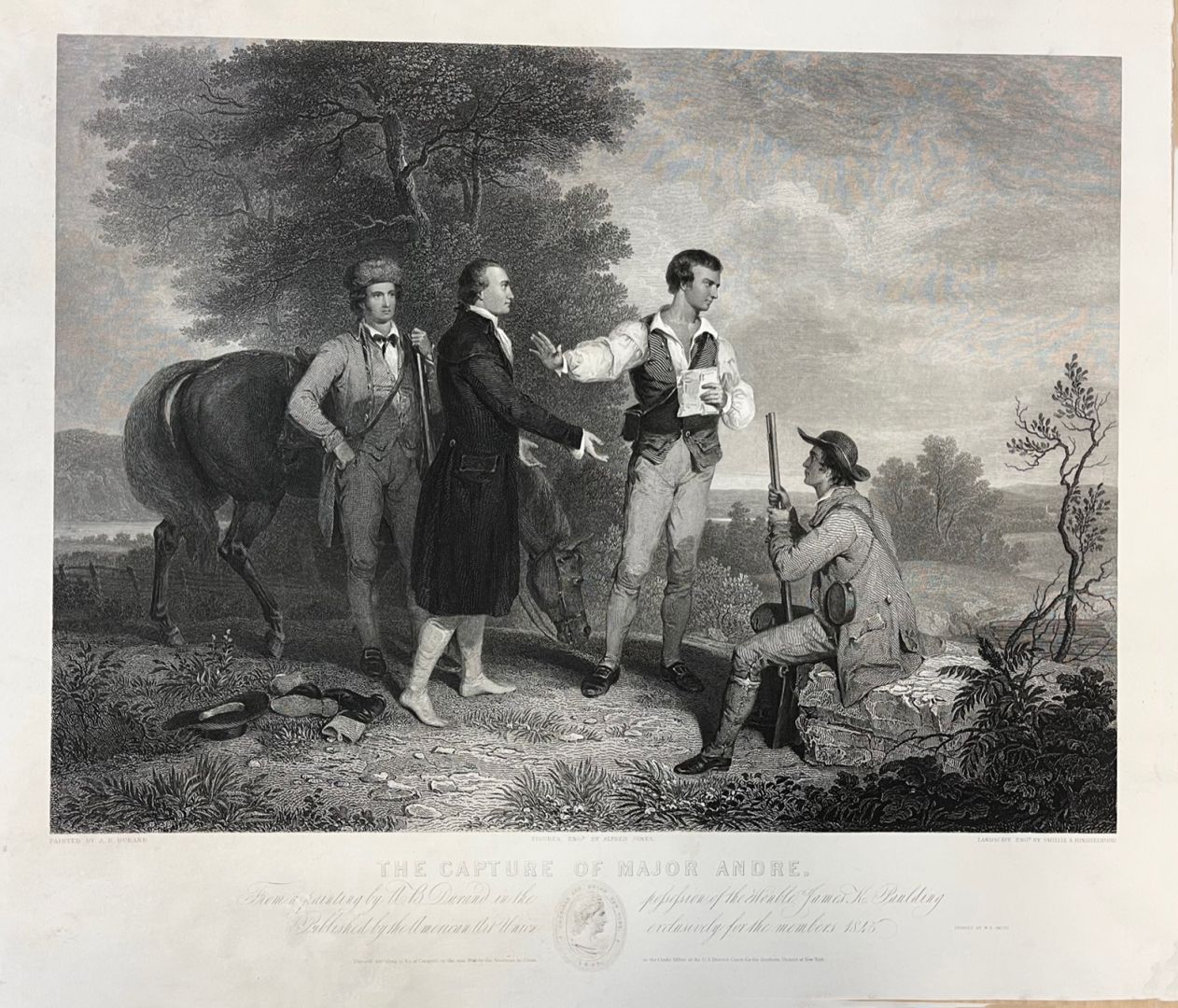Smillie, James David and Robert Hinshelwood and Alfred Jones. THE CAPTURE OF MAJOR ANDRE. Engraving after the painting by Asher B. Durand, 1845. Printed on cream-colored wove paper. 13 1/8 x 17 inches 333 x 431 mm.(image). In the margin, just under the image, left: "Painted by A.M. Durand," center: "Figures engr'd by Alfred Jones," right: "Landscaped engr'd by Smillie & Hinshelwood." Ttiled "The Capture of Major Andre" in the margin, Center, and further annotated "From a painting by A. B. Durandin the possession of the Honble James K.Paulding / Published by the American Art Union exclusively for the members 1845," with the Seal of the American Art Union, center. Also in the margin: "Printed by W. E. Smith," and "Entered accoding to Act of Congress 1846 by The AmericanArt Union in the Clerk's Office of the District Court of the Southern District of New York." In very good condition.John Andre (1750 or 1871 - 1780) was a British Army Officer who served, inter alia, as the head of the Army's Secret Service in America during the Revolutionary War. In this capacity, he met with the American General Benedict Arnold, for the purpose of arranging to pay Arnold 20000 pounds (now about 3.5 million pounds) for the surrender of the fort at West Point, NY, of which Arnold was the commander. Andre arrived by ship, and planned to return on it, but it came under American fire and was forced to leave without him. Arnold gave Andre the plans of the Fort, showing how it could be attacked and captured, provided him with a horse and civilian clothes and he attempted to make his way back to his lines. He was inercepted by three American militiamen, who he mistook for British soldiers, and to whom he made incriminating statements. He was searched, and the plans of West Point were found in his boot. He was arrested by them and turned over to their commander, who, not suspecting that Gen. Arnold was the traitor, reported the capture to him. Arnold immediately left West Point and defected to the British. He lived in England thereafter until his death in 1801. George Washington convened a Court Martial to try Andre. It consisted of some of the most distinguished military men of the Revolutionary War. Andre was found guilty and sentenced to death. He asked Washington to allow him to be shot by firing squad, but he was hanged. Andre was a apparently a very engaging, intelligent and accomplished man, and many on the American side lamented his fate, albeit recognizing that it was deserved by his actions. In 1821 his body was returned to England and he bus buried in Westminster Abbey. During the British occupation of Philadelphia, Andre lived in Benjamin Franklin's house. At the behest of his commanding General, Andre removed a portrait of Franklin from the house. In 1906 this portrait was returned to the U.S. by Britain.James K. Paulding, 1778-1860, was a cousin of John Paulding, one of three militiamen who captured Major Andre. He was a writer of Anti-British satirical works. Although he was from New York, he was pro-slavery and a secessionist. He served as Secretary of the Navy under President Martin Van Buren. The Durand painting was commissioned by the American Artist's Union in 1845. It is now in the collection of the Birmingham Art Museum in Alabama.
Follow us
Contact Us
ed@edpollackfinearts.com
Copyright © 2025 - Edward T. Pollack Fine Arts





